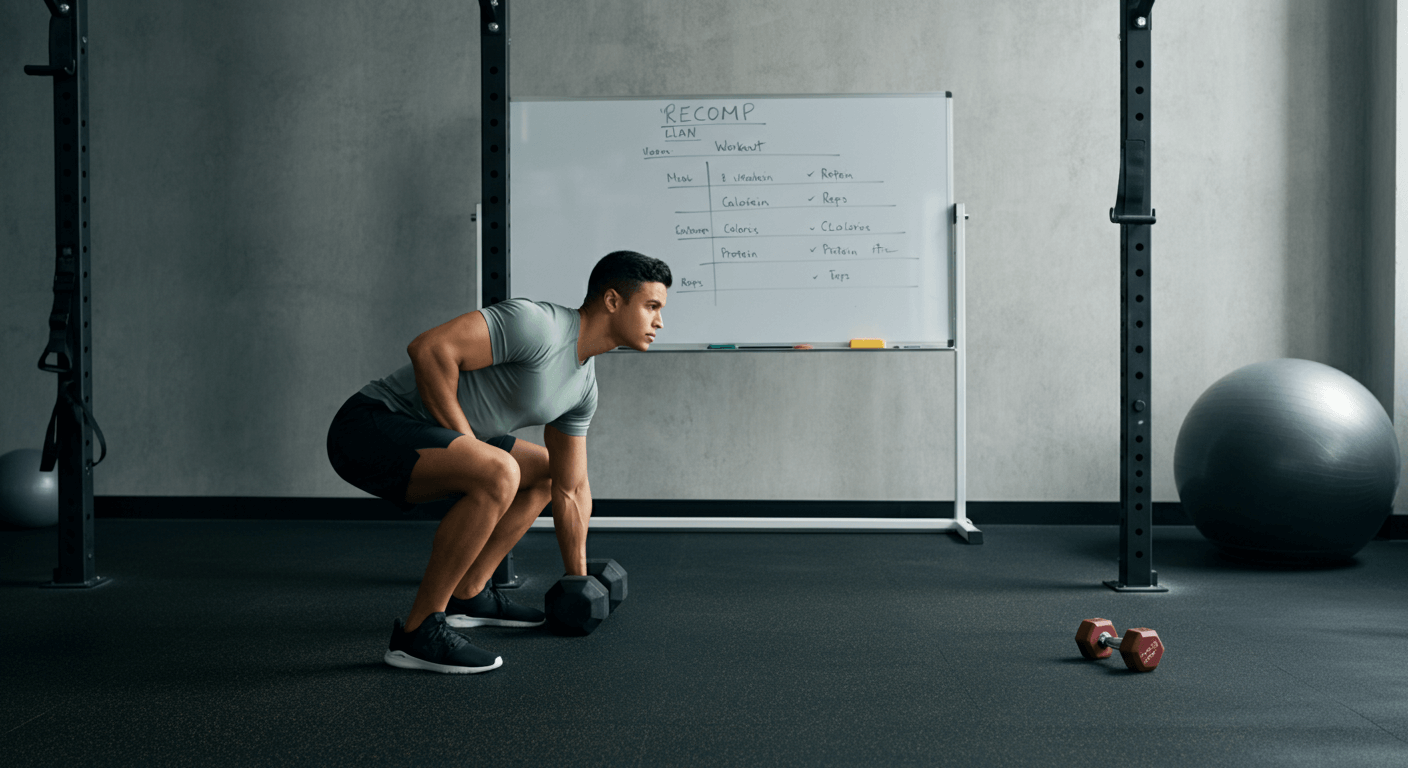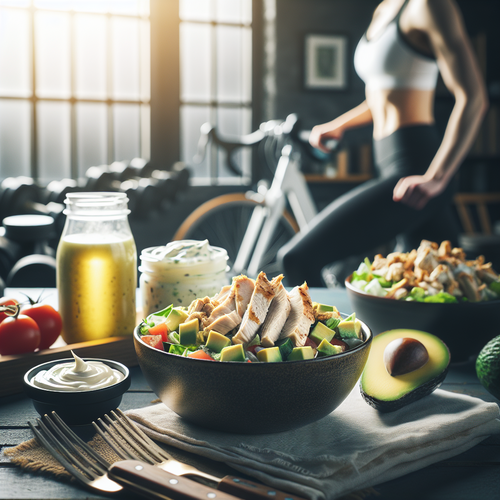How to Lose Fat and Gain Muscle: The Definitive Science & Action Plan for Body Recomposition
Are you tired of the endless cycle of bulking and cutting, only to feel like you’re spinning your wheels? What if you could build muscle and lose fat at the same time? This isn’t a fitness myth; it’s a physiological process known as body recomposition.
This guide bridges the gap between complex exercise science and real-world results. Drawing on findings from leading researchers and evidence-based practice, we provide a definitive, step-by-step blueprint for achieving your physique goals. Forget the vague advice. By the end of this article, you will have a complete, actionable plan—including specific calorie and protein calculations, flexible workout splits, and troubleshooting strategies—to build a stronger, leaner physique simultaneously. Learning how to lose fat and gain muscle is about precision, not just effort.
Table of Contents
- The Science of Body Recomposition: Is It Really Possible?
- The Non-Negotiable Nutrition Protocol for Body Recomposition
- The Muscle-Stimulating Training Blueprint
- Tracking, Adjustments, and Troubleshooting
- Frequently Asked Questions (FAQ)
- Conclusion
The Science of Body Recomposition: Is It Really Possible?
Before diving into the “how,” it’s crucial to understand the “why.” Body recomposition is not magic; it’s a biological balancing act. Your body must be given a reason to build new, metabolically expensive muscle tissue while simultaneously tapping into stored body fat for energy. This requires a precise and intelligent approach to both nutrition and training.
What is Body Recomposition?
Body recomposition is the process of changing the ratio of fat mass to lean mass in the body—specifically, decreasing body fat percentage while simultaneously increasing muscle mass. This stands in stark contrast to traditional “bulk and cut” cycles, where an individual intentionally gains both muscle and fat during a “bulk” (caloric surplus) and then loses both fat and some muscle during a “cut” (caloric deficit).
At a cellular level, this process involves influencing two key metabolic pathways:
- mTOR (mammalian target of rapamycin): This pathway is a central regulator of cell growth, and activating it through resistance training and adequate protein intake signals muscle protein synthesis (muscle building).
- AMPK (AMP-activated protein kinase): This pathway acts as the body’s energy sensor. When activated by a calorie deficit, it signals the body to start burning stored energy, including body fat.
The challenge and art of body recomposition lie in creating an an environment where both pathways can be active. As a 2024 editorial in the National Institutes of Health journal Frontiers in Nutrition explains, the science of body recomposition hinges on a high-protein diet and a consistent resistance training stimulus to promote muscle growth, even while a caloric deficit encourages fat loss.
Who Can Achieve Body Recomposition?
The rate at which someone can achieve body recomposition depends largely on their training experience.
- Beginner and Detrained Individuals: These groups have the highest potential for rapid body recomposition. Their bodies are highly sensitive to the stimulus of resistance training, allowing them to build muscle relatively easily even while in a calorie deficit. If you’re new to lifting or returning after a long break, you’re in a prime position to see significant simultaneous changes.
- Intermediate and Advanced Lifters: For those with years of consistent training under their belt, the process is slower and requires more precision. As you get closer to your genetic potential for muscle mass, it becomes progressively harder to build more. So, can you build muscle in a calorie deficit if you’re already well-trained? Yes, but the results will be more modest. A 2020 review from the National Strength and Conditioning Association (NSCA) confirms that trained individuals can indeed achieve this, but it requires meticulous attention to diet and programming. The practical applications for body recomposition in this population emphasize high protein intake and maintaining training intensity as non-negotiable factors.
For advanced lifters, success might look like gaining 0.5 lbs of muscle while losing 5 lbs of fat over several months, rather than a dramatic change on the scale week to week.
The Non-Negotiable Nutrition Protocol for Body Recomposition
Your diet is not just fuel; it’s the specific set of instructions you give your body. For body recomposition, the instructions are clear: preserve and build muscle while burning fat. This is accomplished with two precise steps.
Step 1: Calculate Your Moderate Calorie Deficit
A common mistake is creating too aggressive of a calorie deficit. While a large deficit accelerates fat loss, it also sends a powerful catabolic (breakdown) signal to the body, increasing the risk of muscle loss. To avoid this, a moderate deficit is essential.
A calorie deficit for muscle gain and fat loss is a delicate balance. The sweet spot is a deficit of approximately 250-500 calories per day below your Total Daily Energy Expenditure (TDEE), which is the number of calories you burn each day.
How to Calculate Your Target:
- Estimate Your TDEE: Use a reliable online TDEE calculator. You will input your age, gender, height, weight, and activity level to get an estimated maintenance calorie number.
- Set Your Deficit: Subtract 250-500 from your TDEE.
- Example: If your TDEE is 2,500 calories, your target range for body recomposition would be 2,000-2,250 calories per day.
This moderate approach provides enough of an energy shortfall to stimulate fat loss without sending your body into a state of panic where it sacrifices muscle tissue.
Step 2: Set Your High-Protein Target for Muscle Growth
Protein is the single most important macronutrient for body recomposition. A high protein intake serves two critical functions in a calorie deficit:
- It provides the building blocks for muscle repair and growth.
- It sends a strong anabolic (building) signal, helping to preserve existing muscle mass.
Scientific evidence consistently points to the need for a protein intake that is significantly higher than standard recommendations. The research-backed range is 1.6 to 3.0 grams of protein per kilogram of body weight (or roughly 0.7 to 1.4 grams per pound).
A 2024 randomized controlled trial published in Frontiers in Sports and Active Living directly supported the powerful effect of a high-protein diet and resistance training. The study found that individuals consuming higher protein levels saw more favorable changes in body composition and strength. This answers the key question of how much protein to build muscle in a calorie deficit: for most people, aiming for the middle of this range (around 2.2g/kg or 1g/lb) is a fantastic starting point.
How to Calculate Your Protein Target:
- Convert Your Weight: If you use pounds, divide your weight by 2.2 to get your weight in kilograms (kg).
- Calculate Your Protein Range: Multiply your weight in kg by 1.6 and 3.0 to find your daily protein range in grams.
- Example: An 80kg (176lb) person would aim for a daily protein intake between 128g (80 x 1.6) and 240g (80 x 3.0). A starting target of ~176g (1g per pound) is a solid, achievable goal.
What to Eat: A Sample Meal Plan
Knowing what to eat to lose fat and gain muscle is about prioritizing protein and whole foods. Here is a sample day illustrating how to meet these targets (approx. 2,100 calories and 180g protein):
- Breakfast (8:00 AM): 4 whole eggs scrambled with spinach and 1/2 cup of feta cheese. 1 slice of whole-wheat toast. (Approx. 450 calories, 35g protein)
- Lunch (12:00 PM): 6 oz grilled chicken breast over a large mixed greens salad with cherry tomatoes, cucumbers, bell peppers, and a light vinaigrette dressing. (Approx. 400 calories, 50g protein)
- Afternoon Snack (3:30 PM): 1 cup of plain Greek yogurt mixed with 1 scoop of whey protein powder and a handful of berries. (Approx. 350 calories, 45g protein)
- Dinner (7:00 PM): 6 oz baked salmon fillet with 1 cup of roasted broccoli and 1/2 cup of quinoa. (Approx. 550 calories, 45g protein)
- Evening Snack (Optional): 1/2 cup of cottage cheese. (Approx. 100 calories, 14g protein)
The Muscle-Stimulating Training Blueprint
Nutrition sets the stage, but training is the stimulus that forces your muscles to grow. Without a proper training program, your body has no reason to prioritize building muscle in a calorie deficit.
The Golden Rule: Progressive Overload
Progressive overload is the principle of continually increasing the demands placed on your musculoskeletal system. It is the single most important factor for long-term muscle growth. Your muscles adapt to a certain level of stress; to keep growing, you must consistently give them a new, greater challenge to overcome.
Examples of applying progressive overload:
- Increase Weight: If you bench pressed 135 lbs for 8 reps last week, aim for 140 lbs for 8 reps this week.
- Increase Reps: If you squatted 225 lbs for 6 reps last week, aim for 7 or 8 reps with the same weight this week.
- Increase Sets: If you performed 3 sets of pull-ups last week, aim for 4 sets this week.
- Improve Form/Tempo: Slowing down the eccentric (lowering) phase of a lift can increase time under tension and create a greater stimulus.
The best workout for body recomposition is one where you are meticulously tracking your lifts and consistently striving to improve in some measurable way.
Flexible Workout Splits: Your Plan, Your Schedule
Adherence is key. The best plan is the one you can stick to consistently. Instead of a rigid, demanding routine, choose a split that fits your life. Here are three effective options for a body recomposition plan:
3-Day Split: Full Body
- Ideal for: Beginners or those with limited time.
- Schedule: Monday, Wednesday, Friday.
- Focus: Hit every major muscle group in each session with compound exercises.
4-Day Split: Upper/Lower (Example Below)
- Ideal for: Most intermediate lifters. Allows for more volume per muscle group while ensuring adequate recovery.
- Schedule: Monday (Upper), Tuesday (Lower), Thursday (Upper), Friday (Lower).
- Focus: Split training between the upper and lower body.
Sample 4-Day Upper/Lower Split:
- Day 1: Upper Body Strength
- Bench Press: 3 sets of 5-8 reps
- Barbell Rows: 3 sets of 5-8 reps
- Overhead Press: 3 sets of 6-10 reps
- Pull-Ups or Lat Pulldowns: 3 sets of 6-10 reps
- Bicep Curls: 2 sets of 10-15 reps
- Tricep Pushdowns: 2 sets of 10-15 reps
- Day 2: Lower Body Strength
- Barbell Squats: 3 sets of 5-8 reps
- Romanian Deadlifts: 3 sets of 8-12 reps
- Leg Press: 3 sets of 8-12 reps
- Hamstring Curls: 3 sets of 10-15 reps
- Calf Raises: 4 sets of 10-15 reps
- Day 3: Upper Body Hypertrophy
- Incline Dumbbell Press: 3 sets of 8-12 reps
- Seated Cable Rows: 3 sets of 8-12 reps
- Dumbbell Shoulder Press: 3 sets of 10-15 reps
- T-Bar Rows: 3 sets of 10-15 reps
- Lateral Raises: 3 sets of 15-20 reps
- Day 4: Lower Body Hypertrophy
- Leg Press: 3 sets of 10-15 reps
- Bulgarian Split Squats: 3 sets of 8-12 reps per leg
- Leg Extensions: 3 sets of 12-15 reps
- Lying Leg Curls: 3 sets of 12-15 reps
- Seated Calf Raises: 4 sets of 15-20 reps
5-Day Split: “Bro” Split / Body Part Split
- Ideal for: More advanced lifters who want to maximize volume on individual body parts.
- Schedule: Mon (Chest), Tue (Back), Wed (Legs), Thu (Shoulders), Fri (Arms).
- Focus: Dedicate each session to 1-2 muscle groups.
Tracking, Adjustments, and Troubleshooting
Body recomposition is a marathon, not a sprint. The changes are subtle and gradual, which can be mentally challenging. This is why tracking your progress correctly is vital.
Signs of Body Recomposition: How to Track Progress Beyond the Scale
The scale can be a liar during body recomposition. As you gain dense muscle and lose fluffy fat, your weight may stay the same or even increase slightly. This is normal and a good sign! Focus on these metrics instead, as they are the true signs of body recomposition:
- Progress Photos: Take photos from the front, side, and back every 4 weeks in the same lighting. This is the #1 tool for seeing visual changes.
- Body Measurements: Use a tape measure to track your waist, hips, chest, and arms every 4 weeks. A shrinking waist while your arm measurement stays the same or grows is a definitive sign of success.
- Gym Performance: Are your lifts going up? If you are consistently getting stronger (progressive overload), you are building or at least maintaining muscle.
- How Your Clothes Fit: Are your pants looser around the waist but tighter around the glutes? Is your shirt tighter on your arms and shoulders? This is body recomposition in action.
Common Problem: “My Weight Isn’t Dropping!”
This is the most common concern. Remember: you are trying to lose fat, not just weight. Muscle is significantly denser than fat, meaning one pound of muscle takes up less space than one pound of fat. If your progress photos show a leaner physique and your measurements confirm a smaller waist, you are succeeding, regardless of what the scale says. Trust the process and rely on your non-scale victories for motivation.
Common Problem: “I’m Low on Energy / My Lifts Have Stalled.”
Feeling fatigued or hitting a strength plateau can happen. Before making drastic changes, consider these troubleshooting tips:
- Nutrient Timing: Try consuming a small meal with carbohydrates (e.g., a banana or a small bowl of oatmeal) 60-90 minutes before your workout to boost performance.
- Check Your Deficit: Your calorie deficit may be slightly too aggressive. Try increasing your daily calories by 100-150 for a week and see how your energy and strength respond.
- Prioritize Sleep: Lack of quality sleep (7-9 hours per night) crushes recovery and performance. This is often the most overlooked factor.
- Schedule a Deload Week: You can’t push at 100% intensity forever. Every 8-12 weeks, plan a “deload” week where you reduce your training volume and/or intensity by about 50% to allow your body to fully recover and come back stronger.
Frequently Asked Questions (FAQ)
How is body recomposition different for women?
The fundamental principles are identical for everyone: a moderate calorie deficit, high protein intake, and progressive overload. However, there are some nuances for body recomposition for women. Women generally have a lower metabolic rate and less muscle mass than men of the same weight, meaning their maintenance calories are often lower. Hormonal fluctuations throughout the menstrual cycle can also impact energy levels, strength, and water retention. The key is to apply the same core principles while being mindful of these factors and listening to your body.
How long does body recomposition take?
Patience is paramount. Body recomposition is a much slower process than a dedicated bulk or cut. For beginners, visible changes can often be seen within 2-3 months. For experienced lifters, it’s a game of inches, where small, positive changes accumulate over 6-12 months or longer. Set realistic expectations and focus on long-term consistency.
What are the best supplements for body recomposition?
First, supplements are not necessary for success. Your focus should be on your diet and training. However, a few evidence-backed supplements can be convenient and beneficial:
- Protein Powder (Whey or Casein): An easy and cost-effective way to hit your high-protein targets.
- Creatine Monohydrate: The most researched supplement in existence. It helps improve strength, power output, and muscle mass by increasing the availability of energy for short, explosive efforts. Take 3-5 grams daily.
Avoid any “fat-burning” pills or magic powders. They are largely ineffective and a waste of money. Stick to the basics.
Conclusion
Building a stronger, leaner physique doesn’t have to involve frustrating cycles of gaining and losing weight. By focusing on the three pillars of successful body recomposition, you can achieve your goals in a more sustainable and rewarding way.
Let’s recap the blueprint:
- A Moderate, High-Protein Calorie Deficit: Provide your body with enough energy to train hard but in a slight deficit to encourage fat loss, all while consuming high protein (1.6-3.0 g/kg) to protect and build muscle.
- A Focus on Progressive Overload: Your training must consistently challenge your muscles to get stronger. Track your workouts and strive for improvement every week.
- Patient, Multi-Faceted Progress Tracking: Ditch the scale as your only metric. Use photos, measurements, and your training logbook to see the real picture of your success.
By following this scientific, actionable blueprint, you can finally break free from the ‘bulk and cut’ cycle. You have the knowledge and the plan to build the body you want—simultaneously.
Ready to build the complete plan? Download ‘The Ultimate Body Recomposition Blueprint’—our free, comprehensive PDF with workout trackers, a nutrition calculator, and sample meal plans to start your journey today.








